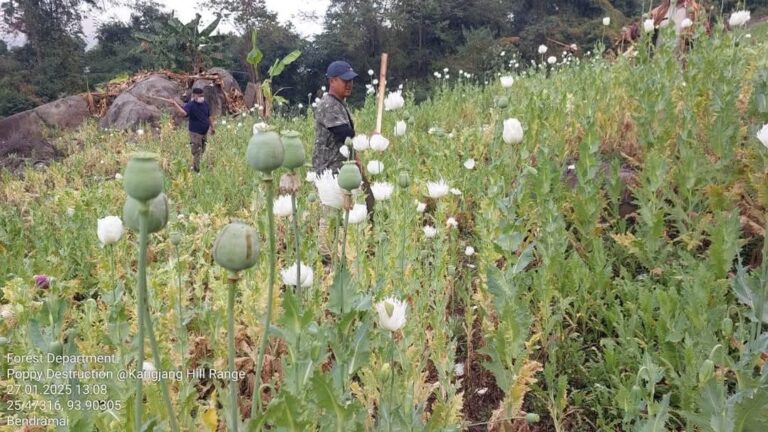Assam Rifles Foils Cross-Border Smuggling Attempt in Manipur’s Moreh
Summary:
In Moreh, Manipur, the Assam Rifles intercepted a smuggling operation involving 70 sacks of areca nuts, valued at approximately ₹30.24 lakh, along the India-Myanmar border. Following suspicions during a routine check, troops approached a halted vehicle, causing its occupants to flee. The seized items were then handed over to customs authorities.
Full Article
Introduction: Smuggling Along India-Myanmar Border Intensifies
India’s northeastern region, especially Manipur’s Moreh, has become a hotbed for cross-border smuggling. The recent operation thwarted by Assam Rifles sheds light on the magnitude and frequency of illegal trade between India and Myanmar. But why is this region so susceptible to smuggling? What are the challenges for the security forces here? Let’s dive deeper into the dynamics of this event and its broader implications on regional security and economy.
The Incident: How Assam Rifles Foiled the Smuggling Bid
During a routine patrol at the New Mongjang Road junction in Moreh, Assam Rifles personnel noticed a suspicious vehicle. When approached, the vehicle’s occupants fled, abandoning it with hidden contraband – 70 sacks of areca nuts. The consignment, covered under cartons of food, was swiftly confiscated, while authorities launched further investigations. Smuggling of areca nuts is a frequent issue along India’s border, due to high international demand and lucrative prices.
Why Are Areca Nuts Smuggled?
Areca nuts are a major crop in Southeast Asia, used widely for betel chewing. While India has restrictions on imported areca nuts, due to potential quality concerns and trade protection, demand remains high. Smugglers exploit this, moving areca nuts across the India-Myanmar border for a significant profit. For context, Manipur’s border with Myanmar is largely porous, making enforcement challenging.
Security Measures in Place
- Regular Patrols and Checkpoints: Assam Rifles and other security forces regularly patrol and establish mobile checkpoints to counter smuggling activities.
- Local Intelligence Networks: Effective intelligence collection in border villages helps detect unusual movement and patterns associated with smuggling.
- Collaboration with Customs and Local Police: Cross-agency coordination strengthens the enforcement of anti-smuggling laws.
Despite these efforts, smugglers continue to exploit the challenging terrain and local support networks, underscoring the need for comprehensive strategies to tackle the issue.
Challenges in Curbing Smuggling Activities
Smuggling in this region isn’t only about bypassing taxes – it has roots in complex socio-economic issues. The porous border, along with limited economic opportunities in the region, drives locals towards illegal cross-border trade. Many locals, entangled in the smuggling network, often see this as a primary source of livelihood, which complicates law enforcement.
- Porous Border with Myanmar: The Indo-Myanmar border stretches over 1,600 kilometers, with rugged terrain and dense forests making monitoring difficult.
- High-Profit Margins for Smugglers: Areca nuts and other smuggled goods fetch high prices, incentivizing smugglers despite the risks involved.
- Lack of Employment in Border Areas: Limited employment options make smuggling an appealing income source, involving villagers and even youth.
Potential Solutions: How Can We Strengthen Border Security?
The Assam Rifles’ recent success highlights ongoing efforts but also shows areas for improvement in tackling cross-border crime. Here’s what can strengthen this battle against smuggling:
- Enhanced Surveillance Technology: Drones, sensors, and high-tech surveillance equipment can provide 24/7 monitoring across the border.
- Community Engagement Programs: Educating border communities about the dangers of smuggling can reduce local support for these activities.
- Cross-Border Cooperation: Collaborating with Myanmar’s authorities can help curtail the flow of contraband goods.
Conclusion: The Road Ahead
Manipur’s Moreh has once again been spotlighted in India’s fight against cross-border smuggling, and while the Assam Rifles’ interception of this latest smuggling attempt is a victory, it underlines ongoing challenges. Only with robust border security measures, community cooperation, and economic development initiatives will this region move closer to eliminating such illicit trade.
FAQs
- What was seized in the recent Assam Rifles operation in Manipur?
- Troops intercepted 70 sacks of areca nuts during a smuggling attempt in Moreh.
- Why is areca nut smuggling prevalent along the India-Myanmar border?
- Due to high demand and restrictions on imports, areca nuts are a lucrative item for smugglers.
- How do smugglers operate across the porous Indo-Myanmar border?
- Smugglers exploit rugged terrain and local networks to transport goods illegally.
- What challenges do security forces face in preventing smuggling in Moreh?
- Difficult terrain, local economic factors, and high-profit margins complicate anti-smuggling efforts.
- What can be done to reduce smuggling along the Manipur-Myanmar border?
- Enhanced technology, community programs, and cross-border cooperation are potential solutions.



